Matteo Matteucci
AgriGS-SLAM: Orchard Mapping Across Seasons via Multi-View Gaussian Splatting SLAM
Oct 30, 2025Abstract:Autonomous robots in orchards require real-time 3D scene understanding despite repetitive row geometry, seasonal appearance changes, and wind-driven foliage motion. We present AgriGS-SLAM, a Visual--LiDAR SLAM framework that couples direct LiDAR odometry and loop closures with multi-camera 3D Gaussian Splatting (3DGS) rendering. Batch rasterization across complementary viewpoints recovers orchard structure under occlusions, while a unified gradient-driven map lifecycle executed between keyframes preserves fine details and bounds memory. Pose refinement is guided by a probabilistic LiDAR-based depth consistency term, back-propagated through the camera projection to tighten geometry-appearance coupling. We deploy the system on a field platform in apple and pear orchards across dormancy, flowering, and harvesting, using a standardized trajectory protocol that evaluates both training-view and novel-view synthesis to reduce 3DGS overfitting in evaluation. Across seasons and sites, AgriGS-SLAM delivers sharper, more stable reconstructions and steadier trajectories than recent state-of-the-art 3DGS-SLAM baselines while maintaining real-time performance on-tractor. While demonstrated in orchard monitoring, the approach can be applied to other outdoor domains requiring robust multimodal perception.
SCENEFORGE: Enhancing 3D-text alignment with Structured Scene Compositions
Sep 19, 2025Abstract:The whole is greater than the sum of its parts-even in 3D-text contrastive learning. We introduce SceneForge, a novel framework that enhances contrastive alignment between 3D point clouds and text through structured multi-object scene compositions. SceneForge leverages individual 3D shapes to construct multi-object scenes with explicit spatial relations, pairing them with coherent multi-object descriptions refined by a large language model. By augmenting contrastive training with these structured, compositional samples, SceneForge effectively addresses the scarcity of large-scale 3D-text datasets, significantly enriching data complexity and diversity. We systematically investigate critical design elements, such as the optimal number of objects per scene, the proportion of compositional samples in training batches, and scene construction strategies. Extensive experiments demonstrate that SceneForge delivers substantial performance gains across multiple tasks, including zero-shot classification on ModelNet, ScanObjNN, Objaverse-LVIS, and ScanNet, as well as few-shot part segmentation on ShapeNetPart. SceneForge's compositional augmentations are model-agnostic, consistently improving performance across multiple encoder architectures. Moreover, SceneForge improves 3D visual question answering on ScanQA, generalizes robustly to retrieval scenarios with increasing scene complexity, and showcases spatial reasoning capabilities by adapting spatial configurations to align precisely with textual instructions.
Chartwin: a Case Study on Channel Charting-aided Localization in Dynamic Digital Network Twins
Aug 12, 2025Abstract:Wireless communication systems can significantly benefit from the availability of spatially consistent representations of the wireless channel to efficiently perform a wide range of communication tasks. Towards this purpose, channel charting has been introduced as an effective unsupervised learning technique to achieve both locally and globally consistent radio maps. In this letter, we propose Chartwin, a case study on the integration of localization-oriented channel charting with dynamic Digital Network Twins (DNTs). Numerical results showcase the significant performance of semi-supervised channel charting in constructing a spatially consistent chart of the considered extended urban environment. The considered method results in $\approx$ 4.5 m localization error for the static DNT and $\approx$ 6 m in the dynamic DNT, fostering DNT-aided channel charting and localization.
Large-Scale LiDAR-Inertial Dataset for Degradation-Robust High-Precision Mapping
Jul 28, 2025Abstract:This paper introduces a large-scale, high-precision LiDAR-Inertial Odometry (LIO) dataset, aiming to address the insufficient validation of LIO systems in complex real-world scenarios in existing research. The dataset covers four diverse real-world environments spanning 60,000 to 750,000 square meters, collected using a custom backpack-mounted platform equipped with multi-beam LiDAR, an industrial-grade IMU, and RTK-GNSS modules. The dataset includes long trajectories, complex scenes, and high-precision ground truth, generated by fusing SLAM-based optimization with RTK-GNSS anchoring, and validated for trajectory accuracy through the integration of oblique photogrammetry and RTK-GNSS. This dataset provides a comprehensive benchmark for evaluating the generalization ability of LIO systems in practical high-precision mapping scenarios.
From Pixels to Graphs: using Scene and Knowledge Graphs for HD-EPIC VQA Challenge
Jun 10, 2025Abstract:This report presents SceneNet and KnowledgeNet, our approaches developed for the HD-EPIC VQA Challenge 2025. SceneNet leverages scene graphs generated with a multi-modal large language model (MLLM) to capture fine-grained object interactions, spatial relationships, and temporally grounded events. In parallel, KnowledgeNet incorporates ConceptNet's external commonsense knowledge to introduce high-level semantic connections between entities, enabling reasoning beyond directly observable visual evidence. Each method demonstrates distinct strengths across the seven categories of the HD-EPIC benchmark, and their combination within our framework results in an overall accuracy of 44.21% on the challenge, highlighting its effectiveness for complex egocentric VQA tasks.
Mapping User Trust in Vision Language Models: Research Landscape, Challenges, and Prospects
May 08, 2025Abstract:The rapid adoption of Vision Language Models (VLMs), pre-trained on large image-text and video-text datasets, calls for protecting and informing users about when to trust these systems. This survey reviews studies on trust dynamics in user-VLM interactions, through a multi-disciplinary taxonomy encompassing different cognitive science capabilities, collaboration modes, and agent behaviours. Literature insights and findings from a workshop with prospective VLM users inform preliminary requirements for future VLM trust studies.
OpenFusion++: An Open-vocabulary Real-time Scene Understanding System
Apr 27, 2025Abstract:Real-time open-vocabulary scene understanding is essential for efficient 3D perception in applications such as vision-language navigation, embodied intelligence, and augmented reality. However, existing methods suffer from imprecise instance segmentation, static semantic updates, and limited handling of complex queries. To address these issues, we present OpenFusion++, a TSDF-based real-time 3D semantic-geometric reconstruction system. Our approach refines 3D point clouds by fusing confidence maps from foundational models, dynamically updates global semantic labels via an adaptive cache based on instance area, and employs a dual-path encoding framework that integrates object attributes with environmental context for precise query responses. Experiments on the ICL, Replica, ScanNet, and ScanNet++ datasets demonstrate that OpenFusion++ significantly outperforms the baseline in both semantic accuracy and query responsiveness.
Rendering Anywhere You See: Renderability Field-guided Gaussian Splatting
Apr 27, 2025Abstract:Scene view synthesis, which generates novel views from limited perspectives, is increasingly vital for applications like virtual reality, augmented reality, and robotics. Unlike object-based tasks, such as generating 360{\deg} views of a car, scene view synthesis handles entire environments where non-uniform observations pose unique challenges for stable rendering quality. To address this issue, we propose a novel approach: renderability field-guided gaussian splatting (RF-GS). This method quantifies input inhomogeneity through a renderability field, guiding pseudo-view sampling to enhanced visual consistency. To ensure the quality of wide-baseline pseudo-views, we train an image restoration model to map point projections to visible-light styles. Additionally, our validated hybrid data optimization strategy effectively fuses information of pseudo-view angles and source view textures. Comparative experiments on simulated and real-world data show that our method outperforms existing approaches in rendering stability.
MARS: a Multimodal Alignment and Ranking System for Few-Shot Segmentation
Apr 10, 2025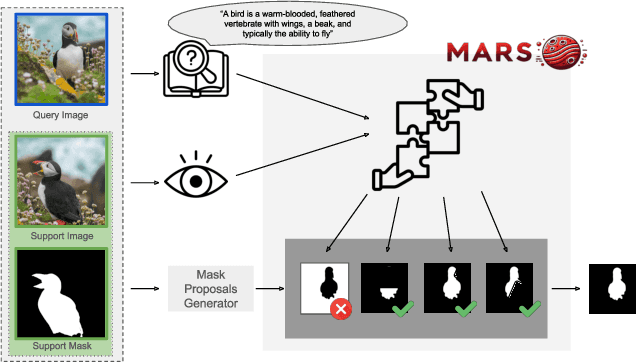

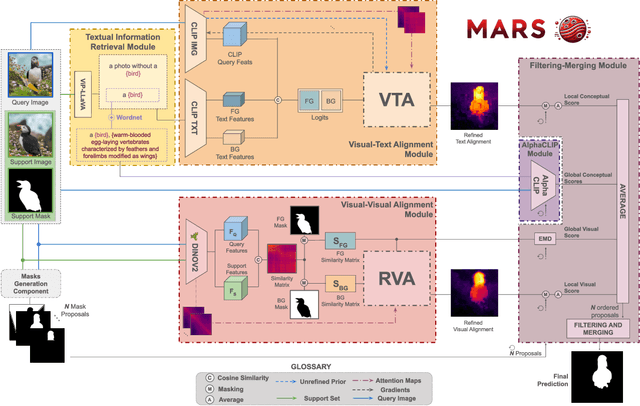

Abstract:Current Few Shot Segmentation literature lacks a mask selection method that goes beyond visual similarity between the query and example images, leading to suboptimal predictions. We present MARS, a plug-and-play ranking system that leverages multimodal cues to filter and merge mask proposals robustly. Starting from a set of mask predictions for a single query image, we score, filter, and merge them to improve results. Proposals are evaluated using multimodal scores computed at local and global levels. Extensive experiments on COCO-20i, Pascal-5i, LVIS-92i, and FSS-1000 demonstrate that integrating all four scoring components is crucial for robust ranking, validating our contribution. As MARS can be effortlessly integrated with various mask proposal systems, we deploy it across a wide range of top-performer methods and achieve new state-of-the-art results on multiple existing benchmarks. Code will be available upon acceptance.
Your Image Generator Is Your New Private Dataset
Apr 08, 2025
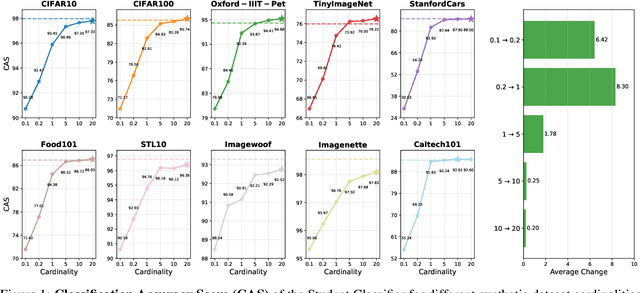
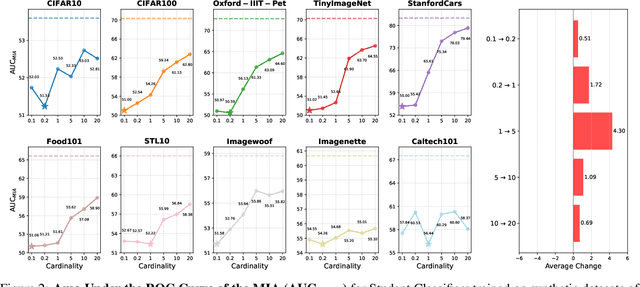
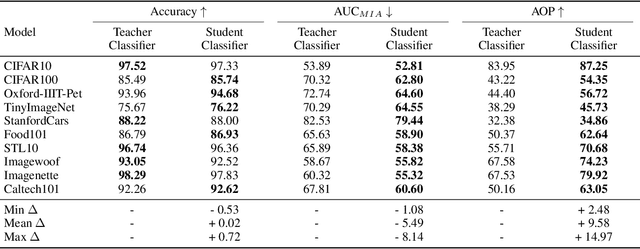
Abstract:Generative diffusion models have emerged as powerful tools to synthetically produce training data, offering potential solutions to data scarcity and reducing labelling costs for downstream supervised deep learning applications. However, effectively leveraging text-conditioned image generation for building classifier training sets requires addressing key issues: constructing informative textual prompts, adapting generative models to specific domains, and ensuring robust performance. This paper proposes the Text-Conditioned Knowledge Recycling (TCKR) pipeline to tackle these challenges. TCKR combines dynamic image captioning, parameter-efficient diffusion model fine-tuning, and Generative Knowledge Distillation techniques to create synthetic datasets tailored for image classification. The pipeline is rigorously evaluated on ten diverse image classification benchmarks. The results demonstrate that models trained solely on TCKR-generated data achieve classification accuracies on par with (and in several cases exceeding) models trained on real images. Furthermore, the evaluation reveals that these synthetic-data-trained models exhibit substantially enhanced privacy characteristics: their vulnerability to Membership Inference Attacks is significantly reduced, with the membership inference AUC lowered by 5.49 points on average compared to using real training data, demonstrating a substantial improvement in the performance-privacy trade-off. These findings indicate that high-fidelity synthetic data can effectively replace real data for training classifiers, yielding strong performance whilst simultaneously providing improved privacy protection as a valuable emergent property. The code and trained models are available in the accompanying open-source repository.
 Add to Chrome
Add to Chrome Add to Firefox
Add to Firefox Add to Edge
Add to Edge